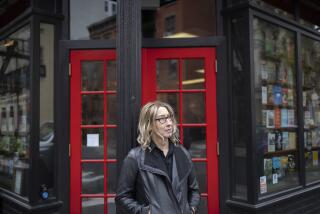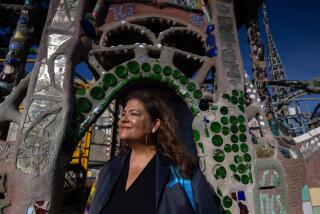The Best of Bush
- Share via
OLLEGE STATION, Texas — History will bear me out, particularly as I shall write that history myself. --Winston Churchill
*
Stashed away in the far reaches of the storeroom is a corrugated-board cutout of a torso and head. The name of the 41st president of the United States is printed on it in a matter-of-fact hand. But the block letters are blood red.
The silhouette was found in the headquarters of Manuel Noriega, the Panamanian strongman who surrendered to invading U. S. troops on Jan. 3, 1990. Twenty-six bullet holes scar the figure.
The man whose image was so well-targeted came across the effigy a few weeks ago.
“Kinda scary,” said George Bush.
Welcome to the George Bush Presidential Library and Museum. You never know what you’ll find.
The $83-million, 69,500-square-foot Texas limestone and granite attic of the Bush presidency, constructed with privately raised funds, will be dedicated on Thursday on the campus of Texas A&M; University. The sprawling campus, long a friendly home to conservative politics, presents would-be visitors with the prospect of a three-hour drive from Dallas or 1 1/2 hours from Houston.
Here are the minutiae of the man, from the paper clips that he kept in his desk to the gift of a needlepoint depiction of broccoli sent by an admirer. (“That’s the way I like to see my broccoli,” said Bush, ever ready to advertise his aversion to the vegetable, in his thank-you note.)
Here are the artifacts of an era: a World War II TBM Avenger torpedo bomber, just like the one he was flying when he was shot down trying to destroy a Japanese communications post on Chi Chi Jima, and his hand-printed flight log entry: “CRASH LANDING IN SEA NEAR BONIN ISL--ENEMY ACTION.”
Nearby, there is a 1947 Studebaker, its maroon paint known at the time as holiday red. It is a twin of the car he and Barbara Bush drove around West Texas after they headed west to raise their family and seek a livelihood amid the oil fields of Midland and Odessa, so foreign to their ancestry in New England and New York.
Throughout the museum are intensely personal mementos, including three items the former president had carried in his wallet for 40 years: a gold heart-shaped charm inscribed “For the love of Robin,” his elder daughter who died of leukemia at the age of 3 years and 10 months, a pressed four-leaf clover and a newspaper photo of the former Barbara Pierce announcing her engagement to George Bush.
And here are the displays of the presidential triumphs: Towering over the section on the end of the Cold War is a 12-foot-tall, 5,000-pound graffiti-scarred chunk of the Berlin Wall.
Capping a history of the Gulf War against Iraq is the wooden door with iron rivets, known as the Gate of Kuwait, that was unhinged from a royal palace and given to Bush by the sheikdom’s emir. A plaque attached to the display bears the names of each of the Americans killed in that war.
But will visitors see justification for Bush’s declaration that Clarence Thomas was the most qualified jurist to fill the Supreme Court vacancy left by Thurgood Marshall? An in-depth account of the recession of 1991 and Bush’s failure to respond convincingly to it? A video-clip of George Bush saying, one more time, “Read my lips. No new taxes”? Not here.
Where is information about his seeming lack of interest in domestic policy? The bout of intestinal illness that brought him down--and his dinner up--in Japan? The revolving door of the chief of staff’s office? Keep looking.
Perhaps these will surface among the 40 million pages of documents, the first of which will be available to researchers on Jan. 20, 1998, five years after Bush left office. It is a massive collection, encompassing Bush’s eight vice presidential years and the papers of his vice president, Dan Quayle--a largely absent figure in the museum. (By contrast, the Ronald Reagan library contained 50 million documents from his two terms when it opened.)
The museum’s purpose is not to be a perfect public history of Bush’s four years in the White House or of his life. Rather, it is a pastiche from which the visitor comes away with an impression of what it is to be George Bush.
“It is a presidential library; they’re not going to run dirt out there. It is an homage to him and his years and whatever he was able to accomplish,” said W. Lee Hisle, associate vice president for learning resources at the Austin Community College in Texas and president of the Assn. of College and Research Libraries.
“Beyond just being a story of recent U.S. history, there is that theme of giving something back to your country [and] the importance of loyalty, family, tradition,” said David Alsobrook, a career U.S. government archivist who is director of the library and museum.
This, of course, was not a president at ease when it came to expounding on the grand scheme of things.
“One of the things I’ve heard him say is he’s not extremely comfortable with this ‘L’ word--that’s not for ‘liberal,’ it’s for ‘legacy,’ ” Alsobrook said. “I don’t think he’s real comfortable with the term ‘legacy.’ ”
Even the site is humble: The complex is built where A&M;’s Swine Research Center once stood. (The complex also includes an academic building housing A&M;’s economics department, Private Enterprise Research Center, School of Government and Public Service, Center for Presidential Studies and Center for Public Leadership Studies.)
So if you want to hear George Bush taking a Churchillian approach to history, look for it in the details; make of them what you will and write the history yourself.
Take, for example, the detritus of the desk he used at Camp David. Alsobrook visited the presidential retreat in Maryland’s Catoctin Mountains days before Bush left office and, in his words, “essentially stripped everything out.”
His goal was to re-create the scene within the museum, and that is what he is doing.
Bush, said Alsobrook, “felt he made some of his most difficult decisions in this office and he wanted the American people to see it for themselves.”
But even more, the replica and the former president’s audiotape tour of it illustrate how Bush could honor the constitutional office of the presidency without taking too seriously the man who inhabited it.
The desk is in place, and the detritus is coming in from the storage shelves any day: six broad-tipped marking pens. One box of Pepto-Bismol. One pocket-sized bottle of eyeglass cleaner bearing the name of an optometrist in Thurmont, Md., the nearest town to Camp David. One glue stick. A pad of yellow Post-its, each inscribed: “From the desk of George Bush.” One box of staples. One stapler. One box of computer disks--the old double-density kind. Four packages of Velamints. One gum-ball dispenser filled with dog treats, which brought the famous Millie and Ranger running. One blue Camp David coffee mug. And a small electric mug warmer.
*
This is the Pyramid of George Bush, serving the nation’s leader and its instant archeologists as did the Egyptian monuments to the pharaohs, minus the sarcophagi.
From audio speakers above the office comes the voice of the former president recorded a few weeks ago, a tenor of wry amusement coming over him:
“One of the problems with drinking coffee is you drink a half cup, get on to doing other things, and the coffee gets cold. Thus, you waste a day’s cup of coffee. Not so with this cup warmer.”
And then it’s on to the next item:
“This, of course, is the presidential flag. I had one in Camp David--this particular flag. . . . This flag symbolizes all of the wonderful things about the United States of America.”
There is also a replica of the presidential office aboard Air Force One. When the former president and Barbara Bush visited the exhibit, they paced off the space, satisfying themselves that it was an accurate model of his desk and the wrap-around off-white banquette along the starboard wall and aft bulkhead.
There is no model of the Oval Office. Bush felt there were enough faux Ovals in other presidential museums, including Lyndon B. Johnson’s, less than three hours away in Austin, and a modern replica at the Ronald Reagan library and museum in Simi Valley, Alsobrook said.
George and Barbara Bush’s personal contributions are everywhere: from the Ascot Chang shirt--pale blue with epaulets, which he wore on so many informal occasions--to the pages of black-and-white family photographs and even a 1925 home movie showing the future president, in white pants and blouse-like shirt, wobbling along as he took the first steps of his second summer at Kennebunkport, Maine.
Their role in the collection extended to decisions on the clips from Bush speeches, including his “Read my lips” address to the Republican National Convention in 1988--minus the “Read my lips” segment.
“President and Mrs. Bush and their staff had a lot of input in deciding what bites to use,” Also-brook said.
Bush was “a very conscientious, studied, ever-efficient administrative leader, in contrast to his predecessor; [he was] hands-on, knowledgeable about issues, clearly less ideological than Reagan, much more pragmatic,” said Charles E. Jacob, a retired professor of political science at Rutgers University who has carried out research at all of the nation’s presidential libraries except for Reagan’s.
The Bush museum reflects that approach.
As vice president, Bush once said in self-deprecating jest: “I have opinions of my own--strong opinions--but I don’t always agree with them.”
Then, he was illustrating the dance a vice president must perform to support his president. Still, on the walls of the museum, ideology takes a back seat.
But the museum reflects an even larger tenet of the modern American presidency: For all the talk of leadership, the president is captive to the era, forced to respond to events foreign and domestic, social and economic, and master them or fail.
Presidents, Jacob said, are “all such prisoners of events that require reactions.”
In Bush’s case, those events were the bookends to his presidency: opportunities, like the fall of the Berlin Wall, and confinements, like the economic recession from which the nation was already, unknowingly, emerging as it turned him out of office.
But, Jacob said, in presidential museums “the emphasis is on the active part of the presidency, the contributions.”
So here, the focal point shifts--from the bomber slung from the ceiling to the Capitol dome and the north portico of the White House that faces Pennsylvania Avenue and, ultimately, to the Gates of Kuwait.
Each was a touchstone in the life of the 41st president.
More to Read
Sign up for The Wild
We’ll help you find the best places to hike, bike and run, as well as the perfect silent spots for meditation and yoga.
You may occasionally receive promotional content from the Los Angeles Times.






